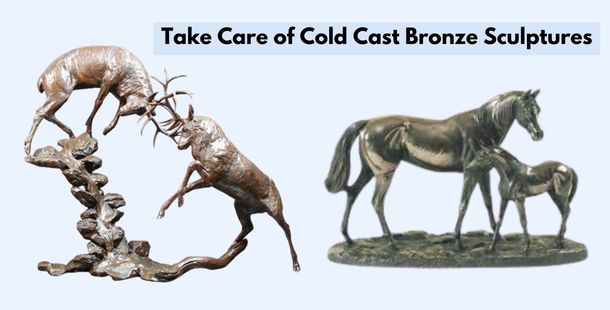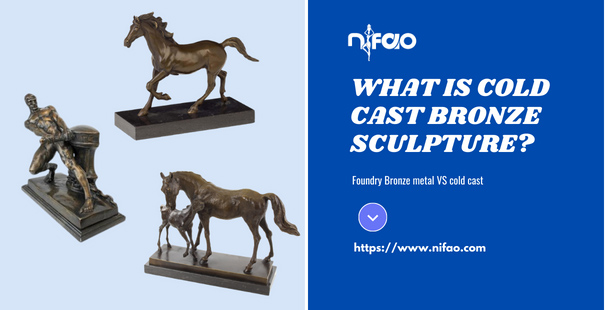Bronze sculptures can come in two different forms – one is foundry or hot cast, and the other one is cold cast resin or bounded.
Whether you are purchasing a bronze sculpture for your private space or ordering one for public spaces, you need to know about both types of bronze statues. Because the difference between the two types of processing can help you choose the right sculpture in terms of price, longevity, and preference.
What is cold cast bronze sculpture?
Cold cast bronze or bounded bronze is a great option when you are looking for a less pricey way to buy a bronze statue.
Process of cold cast bronze statues
Bronze resin sculpture, also known as “cold cast bronze” or bonded bronze, is created by blending bronze powder with epoxy, polyester, or another resin and pouring the mixture into a reusable rubber mold.
The process doesn’t include the “long wax” process which is a significant step in the hot cast bronze process. To secure the shape, artists use fiberglass and resin in the cold casting process. Artists generally use bronze color or patina on the surface of the statue to give it a bronzed look.
To make their sculptures appear made of other materials such as iron, stone, gold, copper, etc. artists use different color powders in the polyester mix. On top of that, they can always use a color on the surface of the sculpture to make it look as required.
How long do cold cast bronze sculptures last?
Whether you are commissioning for a cold cast bronze sculpture or foundry artistry, you should know how long they last.
Indoor cold cast resin sculptures can last an unspecified period of time given the circumstances. These sculptures’ shelf life depends on various factors. They can get damaged pretty quickly in hot temperatures.
Furthermore, they are more fragile in comparison to foundry bronze sculptures. So, statues made by cold casting can get easily broken, and fractured.

Also, dropping or knocking can easily break or crack the sculptures. In addition, depending on the shape, cracks can appear in these statues which can damage them if not taken care of quickly.
Outdoor bounded sculptures generally have a shelf life of 35-40 years, and at most, they can last up to 50 to 100 years.
Outdoor cold cast statues are more prone to environmental damage than indoor sculptures. Along with hot weather, water can damage these artistries as well. Especially, the parts that collect water frequently can get damaged quickly.
That being said, resin sculptures are easier and less costly to mend than hot cast bronze statues.
You can get the mending information of your sculpture from the artists or sellers. They can arrange casters for your statues near your location.
If you are looking for inexpensive bronze statues, you can easily opt for cold cast resin sculptures.
Weight
Bounded or cold cast bronze sculptures normally weigh less than foundry sculptures. Although, it’s not always true. Artists sometimes fill the bounded sculptures with various materials to give them more weight against wind or to stand grounded safely. So, you may find cold cast statues that weigh the same or more than hot cast statues.
We do not recommend filling the larger sculptures with weighing materials as they make the artistries difficult to move from one place to another. There are other options such as internal steel reinforcement, or a beam construction to bury it underground to make the sculpture wind-resistant.
How To Take Care of Cold Cast Bronze Sculptures

Various factors, including the climate, external harm, bird excrement, sap from certain trees, and time can play a role in the appearance and shelf-life of your bronze sculptures.
If you are thinking about purchasing bounded bronze statues, there are a few things that you should consider to get the best out of your purchase.
1. Be it cold cast or hot cast statues, the patina or the coating on the surface of the sculptures will change over the years. In hot cast statues, the appearance becomes green over time due to oxidization, which some people prefer. If you want to keep your sculpture looking shiny and bronzed, perform wax coating twice a year to delay the changing effects.
2. Cold cast statues are more vulnerable to cracks, and weather-related damages. Hot and cold weather can have damaging effects on cold cast artistries.
We recommend you place your sculptures in a safe place and try to keep them in a place with a controlled temperature.
Since you can’t keep the outdoor bounded sculptures in a temperature-controlled place, place them in a shaded place to protect them from hot weather.
As for the winter months, keep them waterproofed and bubble-wrapped to keep them from contracting and damaging. Also, if a bounded bronze sculpture has water features, remove or turn off the water features in the colder months to protect the pipes from expanding and bursting from the frozen water.
3. Handle the cold cast resin statues with care as they are not as strong as hot cast bronze sculptures. Whenever handling bounded artistries, hold them by the thick parts instead of picking them up by the thinner parts to avoid breakages.
Frequently Asked Question
Should I purchase resin statues?
Resin statues are relatively inexpensive and are a great substitute for hot cast bronze statues.
What is hot cast bronze sculpture?
In hot cast sculpture making, artists first create a hollow wax shape of the sculpture. Then they add a thick ceramic layer to coat the shape and leave it to dry completely. Once the shape is completely dry, they melt away the wax (hence, the method is called the “lost wax” method) and pour molten hot bronze inside the hollow shell.
After the sculpture is cooled, they smash away the ceramic layer to expose the bronze shape. Afterward, the surface of the shape is blow-torched with chemicals and/or patina. As the last step of the process, the sculptures are polished with wax.
How to know the difference between a hot cast and a cold cast statue?
Sound is the most effective way to tell the difference between hot cast and bounded resin statues.
If the sculpture sounds metallic when you tap it with another metal, you can tell that it’s a hot cast bronze sculpture.
Cold cast sculptures sound thick and muted when tapped with a metal object.
Related Blog About Bronze Stautes:

